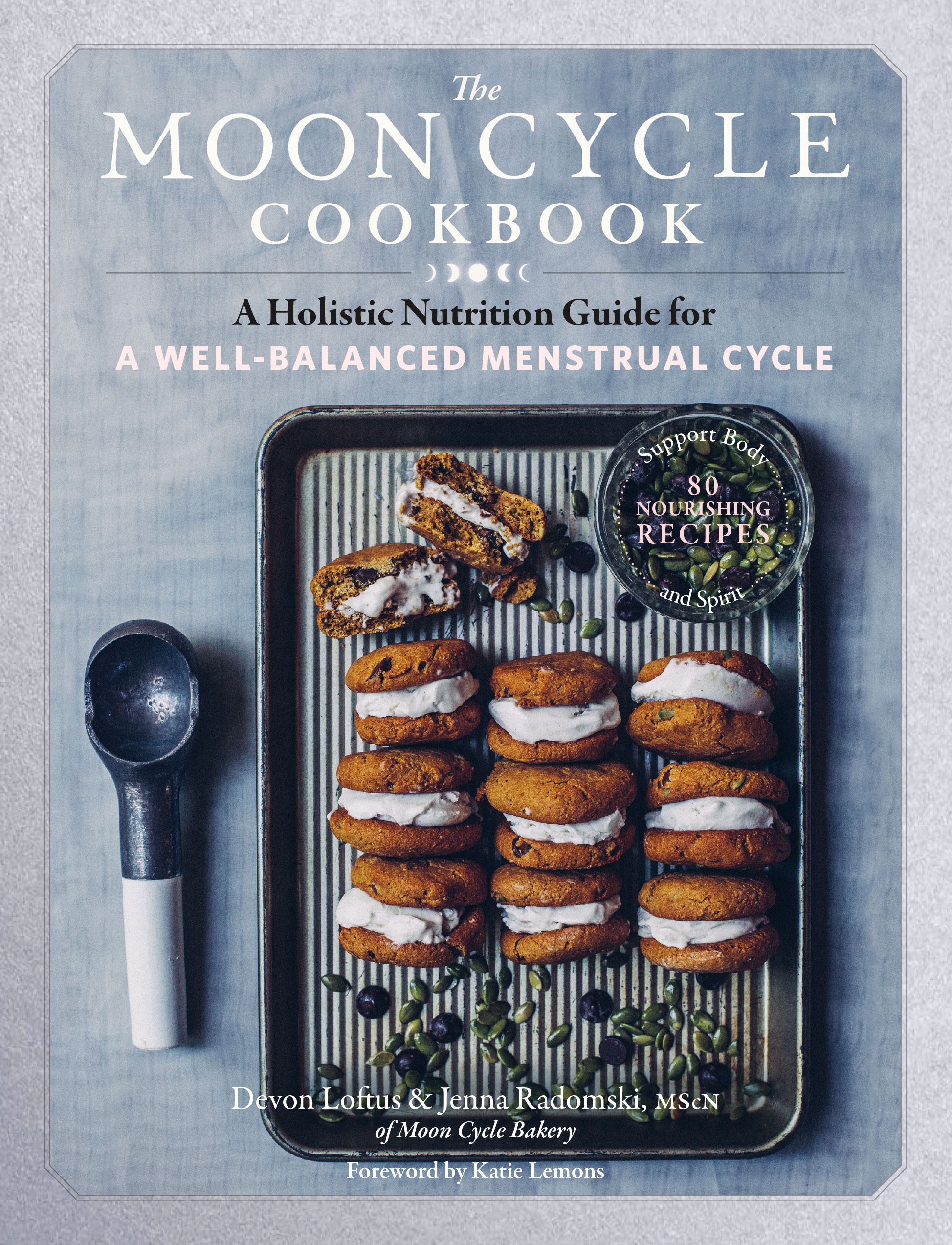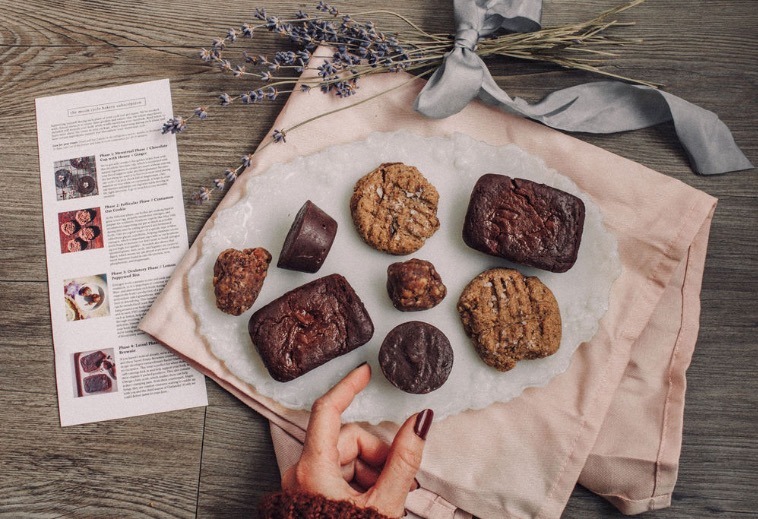
Devon Loftus is helping women nourish their bodies with sweet as well as savory recipes in her new volume, The Moon Cycle Cookbook ($18.95, Storey Publishing).
Loftus, who grew up in Chatham, lives in New Providence, where she founded the online Moon Cycle Bakery to help women during their monthly menstrual cycle. Her bakery offers monthly subscription boxes with treats designed to rebuild micronutrients women regularly lose every 20 to 30 days.
“We know that education leads to empowerment,” says Loftus. In learning more about her own body, she began working with nutritionist Jenna Radomski to craft nourishing recipes driven by science and research.
“We look at micronutrients that we lose throughout the different phases of the cycle, then we work with whole ingredients to help replenish those micronutrients,” Loftus says. “We believe you can feel empowered in the choices you make for your body.”

“The Moon Cycle Cookbook” offers recipes for baked goods as well as savory dishes. Photo courtesy of Storey Publishing/Poppi Photography
When did you start Moon Cycle Bakery?
It began at a mini bachelorette party with some of my friends out in California. We just went around a few bars that night, and at the last stopped where my husband was a chef. He brought us this really decadent, delicious chocolate cake, and one of my friends tapped me on the shoulder and said, “I just had to tell you, this is one of the best things I’ve ever eaten. I don’t know if it’s because I’m going to get my period or not, but I almost cried because it was so good.” I laughed and jokingly said to her, “We’ll bring you a piece of this cake every month.”
When I woke up the next morning, I realized there was something there. Women not only want to be nourished in a physical sense. They also want to be seen and acknowledged, and they even want the sense of reclaiming empowerment in their cycle.
Was baking something you’ve always enjoyed?
I love to bake, and I think it’s because I follow the instructions, and I usually get what I expect. There’s a sense of grounding in that for me. I used to bake all the time growing up with my grandma and great-grandma. Baking with them, there was this sense of checking out of the world because you had to be so present and really put yourself and love into what you’re making.
How did you learn about the connection between food and menstrual cycles?
I was experiencing my own mental and physical health issues, and I started diving into the aspect of holistic wellness. I was in California, and I was working in an industry where I was super stressed out, overworked, and I started to realize what we put into our body matters. I went to a doctor who basically gave me permission to trust myself and know my body. That’s when I got in touch with a holistic nutritionist and toxicologist, and she basically started me on this journey. At that moment, I knew I would be moving forward in a fashion that didn’t prey on women and the cravings we have, but would do the exact opposite and help replenish the micronutrients we lose.
How can people access the Moon Cycle Bakery?
Moon Cycle Bakery is all online, and we ship across the country. We have our treats and subscription service, as well as our dry mixes, which we launched during the pandemic so people had access to these nourishing treats with the safety of making them in their own homes.

Moon Cycle Bakery offers subscription boxes. Photo by Poppi Photography
The cookbook includes cooking as well as baking?
Yes. We have everything from breakfast to lunch, dinner, desserts, treats, snacks and elixirs, like mocktails. We have things from red-wine-braised beef short ribs to chocolate cherry granola to strawberry-coconut lime pops. There’s variations across the board. There are some vegan recipes, meat recipes, vegetarian and gluten-free recipes. Plus all the recipes are very easily modified with whatever dietary preference you have.
Do you have a favorite recipe in the book?
I have a 21-month-old, and it’s hard for me to transition from playing with him to working. Going from high energy to focusing on writing is hard sometimes. This one recipe I’ve been making a lot helps me do that quickly. It’s our honey cinnamon latte. There’s no coffee. It’s just oat milk, or any milk you want, water, honey, ground cinnamon, ginger and a pinch of salt. It is so simple, but it really helps my mind quiet down, and it’s great hot or iced.
How did you put the book together?
Jenna Radomski is our nutritionist, and she is the mastermind behind all the recipes. She really helps infuse the science into everything, and we put education at the forefront. We look at micronutrients that we lose throughout the different phases of the cycle. Then we work with whole ingredients to help replenish those micronutrients. We always say nothing we do is prescriptive because everyone metabolizes at a different rate. We’re each so individual that what worked last month or six months ago might not work tomorrow. It’s just how our bodies are as they heal and grow and evolve.
What exactly are the phases of the menstrual cycle?
Everything [in the book] is designed within the four phases. For example, the menstrual phase is when estrogen and progesterone drop. We often are mentally and physically exhausted, and can be restless or less social. But this is also a time when we can be hyper aware of what we need. It’s really when we should make space for warm and hearty cooking, lots of root vegetables. When we’re looking at creating our treats, and throughout the cookbook, we break down each menstrual cycle and how each recipe reflects what you need in that cycle.
What are examples of foods that help with certain stages?
Magnesium, which drops in the luteal phase and then continues in our menstrual phase, can be found in things like chocolate, avocado, leafy greens, nuts. It is a micronutrient that can help relieve cramping, bloating and headaches. We’re also using a lot of iron, so choosing things like beets, lentils, tofu and pumpkin seeds can replenish zinc and iron. Looking at complex carbs, they can help replenish serotonin and dopamine to help with mood swings and stabilize blood sugar. Things like sweet potatoes can be a great complex carb.
I feel I’m learning about my body just speaking with you.
It’s funny, because we have conversations often where we’re like, “We aren’t really taught this stuff.” This isn’t something you learn in school….We talk a lot about rituals in the book. Looking at ourselves, in a holistic sense, we really want to create this cycle to be something that is intentional and ritualistic so we can ground ourselves and fully embrace whatever is coming up.
What are you hoping the cookbook will do for women?
I really hope it supports women and encourages them to come back to themselves, whatever that looks like and whatever that means. I hope it creates a space for them to prioritize themselves, because life is so busy, and it’s so easy to get swept up in what’s next or who needs me, especially as a woman. I hope it’s a resource and they can feel supported through each cycle, and learn why they’re feeling a certain way. I always told Jenna, “I hope that when people read it, they feel like they’re amidst conversation with friends.” That they’re accepted and acknowledged and supported in whichever ways they need.
